How To Read Music | A Guide For Guitar Players
Understanding Chord Charts, Scales Boxes, Music Sheets and Strumming Patterns
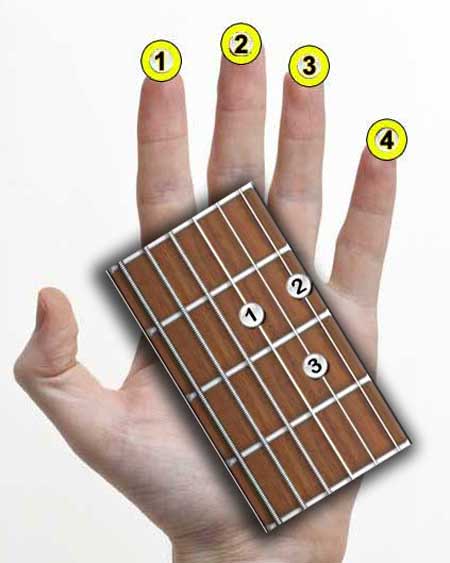 This tutorial has been created specifically for
beginner guitar players
that are approaching to
written music
and symbols for the guitar for the first time.
This tutorial has been created specifically for
beginner guitar players
that are approaching to
written music
and symbols for the guitar for the first time.
During your guitarist career, you'll encounter many different ways in which music is represented on paper (or on digital devices): guitar tabs , chords charts , arpeggios and scales boxes , sheet music, accidentals, tempos, strumming and rhythm notation .
This article will give a basic introduction on how to read music and apply this skill to your guitar studies.
The other day I was listening to a podcast interview with St. Vincent, one of the most notorious musicians of our time, who also happens to be an extremely original guitarist ( here's an episode of guitar moves with her ).
In the interview, she mentioned that in spite of having attended Berklee College of Music for two full years, she can't read sheet music.
But it clearly hasn't been an impediment for her.
But how does a musician of that stature get so far in their career without an ability such as sight-reading?
Well, depending on the music you're into, you may find that most of your heroes either can or can't sight read.
If you were to investigate the way each of your guitar idols learnt their craft, you'll notice that they either practiced by ear (the art of figuring out a piece of music by merely listening closely and then trying to play it) or favored one or another type of musical reading.
For guitar, the main ways to read music are chord charts,scales boxes, tabs, sheet music and strumming patterns .
If you're unsure about which one to focus on, how to tackle each one and whether it's the right type of musical notation for you to learn, we've put together a comprehensive guide to teach you how to read music for guitar and help you become a better musician.
We'll cover each one of the mentioned styles along with some examples that you can try right away.
Guitar Tabs
Tablature is by far the easiest and most welcoming method of reading music for guitar.
In practice, you don't even have to know the names of the notes you're playing in order to read a guitar part and execute it.
Most tabs have six horizontal lines that represent the six strings on a regular guitar.
The line at the top is the thinnest string (usually ‘e') while the line at the bottom is usually the lower E, or your thickest string .
Then, each line will have numbers indicating the fret number where your fingers shall be placed.
If you encounter a 0, that's an open string.

Some people argue that the downside about reading tabs is that there's usually no indication about the rhythm and duration of a note.
The closest it gets to that is by indicating the number of times a note is repeated, but for more specific stuff like tempo and intensity....
well, you simply have to listen closely! To address this issue, you'll find often tabs along with music sheet , as the example shown above.
Which is what, in this writer's humble opinion, makes TAB such a good method for beginners .
You oscillate between reading what someone has figured out for you, and listening to your favorite musicians, which you'll find out is also a good way of becoming closer to figuring stuff out by ear.
Also, there's usually some indication as to the way each string is tuned, as well as other symbols for actions such as slides, muting, or sustained notes.
For a more in-depth look at tablature, which includes how to read guitar tabs symbols, feel free to check out our article on how to read guitar tabs .
Chord Charts
Most modern music is comprised of a certain chord structure, as well as practically any song you encounter.
Another way to easily figure out a song on guitar (specially if you're playing acoustic) is finding the chords for it.
Most of them simply feature the lyrics to the song and indicate the chord that accompanies each moment of the lyrics.
If you don't know all chords by name, that's where a chord chart comes in. You may also find these as " chord boxes " and they usually look like this:

Pretty straightforward isn't it? Still a lot of people wonder how to read guitar chords , so let's take a look at the different parts....
The top roman numerals indicate the fret number .
The bottom line is the lowest string, and each one has the name of the chord it's signaling.
Then, the numbers that are placed on the frets indicate each finger.
"1" would be your index and "4" your pinky.
With the chord on the left, which is the basic structure for most major chords, your index is barring the whole first fret and that's indicated by that long oval with a "1" in it.
Note that the chord on the left has a black "X" next to the lower E.
This means that while playing that chord, that string is muted .
With other chords, such as an A major, some strings will have an "O" or a circle instead of an "X". This means that you play the string open , with no fingers holding it down.
Sometimes you'll find chords charts displayed in vertical position, as shown in the picture below.
The symbols (open strings, muted strings, fingerings) are exactly the same.
In the vertical layout, the E lowest string is on the left, while the thinnest E high string is on the right.
This is the kind of notation that we use in our Free Guitar Chords Ebook
Here you find a detailed guide for learning how to read chords boxes in vertical position.
C major

G major

A minor

F major
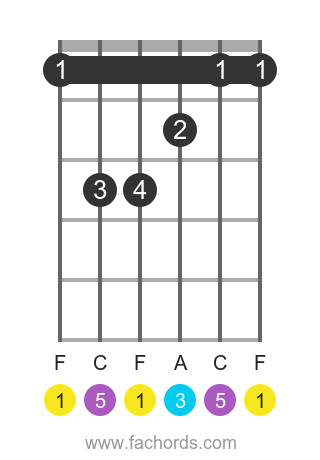
Sheet Music
Although many professional guitarists of all genres have gotten away by mastering only the two previous methods of learning guitar, reading sheet music (also known as sight reading) is a skill you might want to acquire if you're considering going to music school, becoming a session musician , or being proficient at certain genres such as jazz, fusion, and classical.
Even if you're only into more popular and less academic types of music such as rock, pop, and funk , it might motivate you to know that most established artists release official sheet music books for their songs.
While this usually also include a TAB, it means that they're probably the closest and most exact written source to what that guitarist is actually playing.
That being said, in order to read guitar sheet music you must first be able to identify the different parts that comprise it.
The Staff : is basically all the lines and spaces that hold the notes.
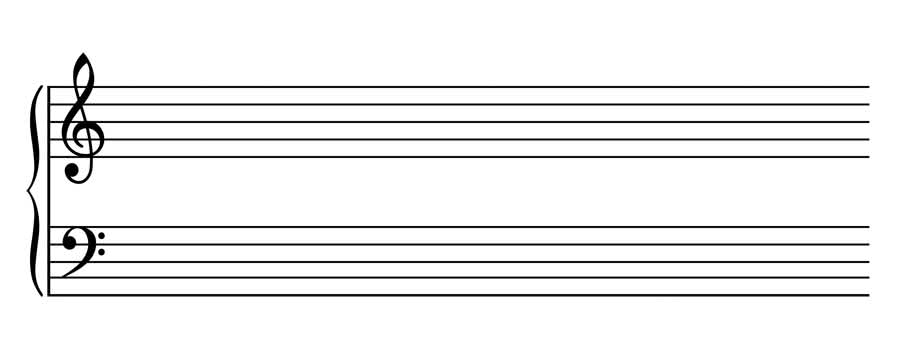
The example above is a one for piano, where the low notes are indicated under a bass clef (lower symbol), which marks an F, and the higher notes are noted under a treble clef (upper symbol).
The guitar, as most higher pitched instruments, is written for a treble clef, which circles the G note.
All notes have a distinct place within the staff, and the easy way to remember them is to note where the staff marks that initial G.
Another common way is the acronym " E very G ood B oy D oes F ine" as noted in this little diagram:

Of course, each space also has a note.
An acronym that can help you remember The Spaces is " FACE ":

Ledger Lines : are the lines above or below the staff that go beyond the E located on the 4th string, 2nd fret of a guitar, and the F located on the 1st string, 1st fret
Those notes are always indicated with those little lines as below:

Key Signatures : These are the symbols found next to the clef that tell you which key that piece of music is in.
They do this by indicating which notes will be sharp or flat anytime they're noted in the staff.
To further help you with key signature, you can download our free pdf with music key signatures and their relationship with the notes of the fretboard
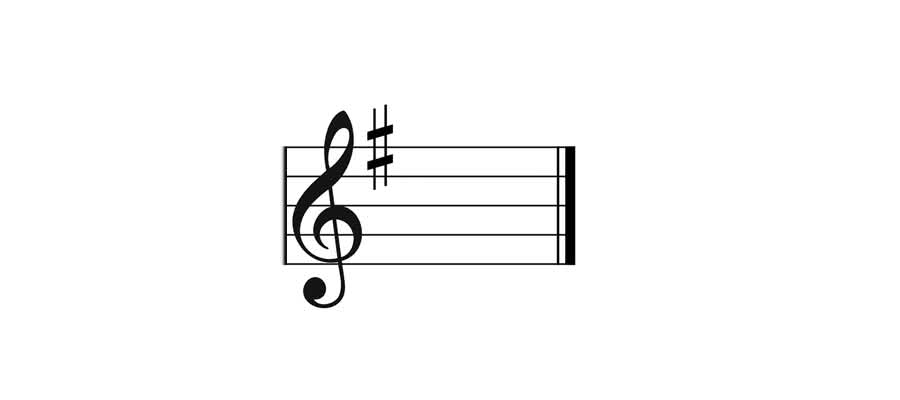
Accidentals : These are notes that don't naturally occur in the key, and thus are marked with a sharp (?), natural (?) or flat (?) symbol.
The following diagram shows how a key signature alters the A's played on the first bar (indicated by that line in the middle of the staff), and on the second bar the A's are natural again so the A sharp must be noted with the pound symbol.
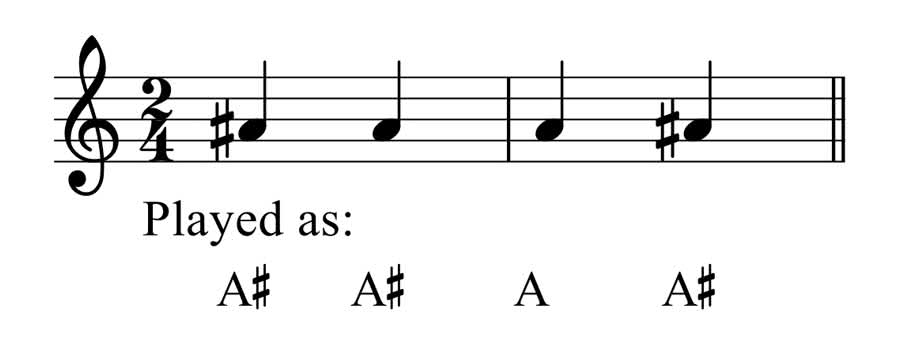
The above diagram also shows number which indicates the Time Signature , which tells you how many beats are in a measure.
Of course, in any piece of sheet music you'll notice that there are several types of symbols for notes .
Their variety is usually an indication of their length.
The most common ones are whole notes (which in a 4/4 time signature last the whole 4 beats of a bar), half notes (2 beats) and quarter notes (1 beat).
You can keep dividing this down to cramp more notes per beat, as the following diagram shows:
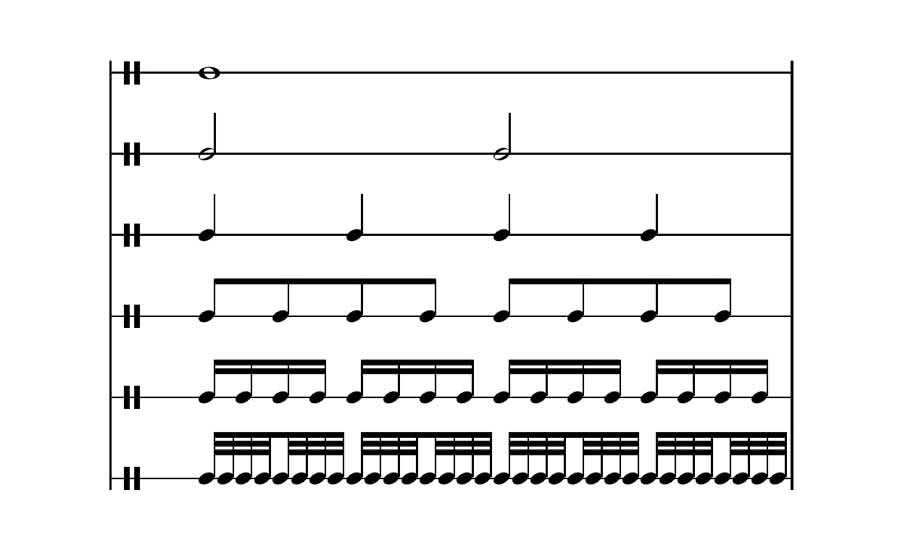
Then you have Rests , which are similar to notes in the sense that they also indicate a specific action through time, but the action in this case is not playing .
So there are whole note rests, half note rests, and so on.
Please note that this is only a general overview of how sheet music is presented for the guitar .
If you'd like to delve deeper and find more resources to teach you how to read guitar sheet music, be sure to check out these lessons from our recommended guitar lessons program .
Strumming Symbols
If you've been learning guitar online, you may have heard of strumming symbols or perhaps even encountered something like this:
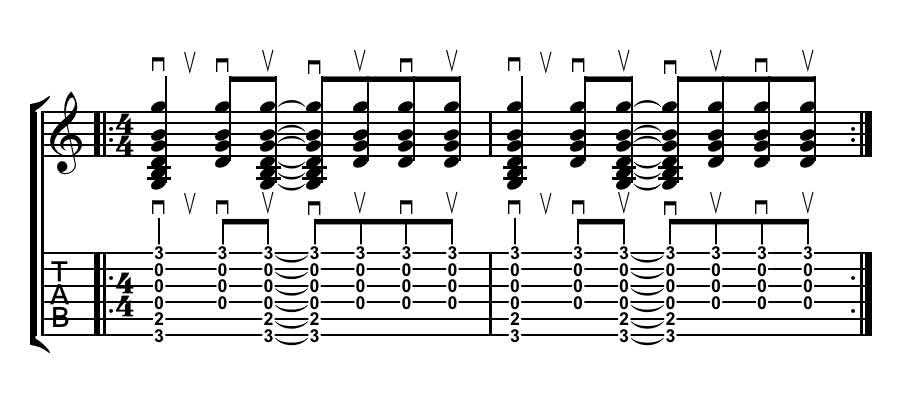
Those symbols on top of both the tab and the sheet music version indicate a strumming pattern.
Quite simply, the first symbol (shaped like a bottomless square) is a down strum .
The other one (shaped like a V) is an up strum .
Also, although the diagram above doesn't show it, you may encounter another symbol that's shaped like an "X".
In strumming notation patterns, that represents a percussive slap.
It really depends on the person or publishing body doing the notation.
When notating strumming patterns, to give you another example, some guitarists use a slash instead of a rounded head for a note.
It's called " Rhythm Slash Notation ", and it looks like the second line on the example below:

Those are all the strumming symbols you may encounter.
These may be helpful at first, but when trying to figure out a strumming pattern, it's often easier to just listen very closely and try to imitate what you hear.
If possible, you could also look up live videos of a particular guitarist and see what their right hand is doing.
Scale Boxes
Finally, you may have also encountered scale boxes .
These aren't really pieces of music to play in a particular manner, but rather diagrams meant to teach you a scale.
There are some simpler diagrams that just show you black dots signaling where to put your fingers to play that scale.
As with chord boxes, the string at the bottom of the diagram is the thickest (E low string)
They usually look like this:

At first glance, they may look very similar to a chord box.
The main difference is that these tell you which notes to play, and you should play them one note at a time, instead of strumming notes together.
Most scale boxes have a way of differentiating the root note of the scale from the other notes, and providing more information.
In the example diagram below, they simply add the names of the note to each fret.
Also, the diagrams shows the note of the scale on the whole fretboard .
By following this diagram, you can play the scale horizontally, vertically, or diagonally, depending on the path you choose to follow.
You can find more information on scales and solos at this link .

In our Free Scales Ebook , we show the scale directly on the fretboard, and on each fret we put the name of the corresponding interval:

Try It Out
Those are the main ways of reading music for guitar .
My honest advice would be to give each of them a try with a particular piece of music you like.
That way you'll find the method that suits you best, or maybe you'll even become proficient with all of them.
Happy jamming!
P.S. You can stay updated on new content by subscribing here.